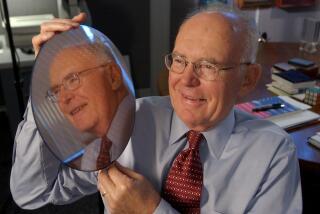Intel Calls Chip Development a Breakthrough
- Share via
SAN FRANCISCO — Proclaiming a major breakthrough in computer chip technology, Intel Corp. on Wednesday announced an improvement in the design of memory chips that could boost performance and cut costs of devices ranging from computers to answering machines.
The Santa Clara, Calif., company said it is the first to have devised a way to store two bits of information in an electronic space formerly limited to one, doubling the capacity of memory chips increasingly used in an array of electronic appliances.
Intel cast the development in dramatic light, saying the new technology “moves beyond Moore’s law,” the legendary prediction made 30 years ago by company co-founder Gordon Moore that the number of transistors on a silicon chip--and therefore its performance--would double every 18 months.
If that law were eclipsed, it would pave the way for previously unthinkable advances in computing power. For that reason, Intel’s announcement sent ripples of wonder through the technology industry Wednesday.
But after examining the new technology, experts cast serious doubt on some of Intel’s claims, and questioned the breadth of the implications for the computer industry.
“Intel has done a really good job of promoting this out of proportion to its true importance,” said Peter Glaskowsky, an analyst at the Microprocessor Report in Sebastopol, Calif. “It is interesting and potentially a competitive advantage, but it doesn’t repeal Moore’s law or anything like it.”
Glaskowsky and others stressed that the technology affects only certain memory chips, known as flash memory, which account for just a fraction of the cost and capabilities of devices such as PCs or digital cameras. Further, he said, the advance has no bearing on the performance of microprocessors, the chips that serve as the brains of personal computers and form the core of Intel’s business.
When pressed, Intel executives acknowledged the limitations: “We prefer to think of it as accelerating Moore’s law for this particular class of memory devices,” said Greg Atwood, director of flash memory architecture at Intel.
With that qualification, analysts agreed the new design is a big improvement.
Computers reduce information to a series of ones and zeros, and that has traditionally been represented in computer memory by the presence or absence of an electronic charge in a transistor. But Intel researchers have found a way to read more subtle gradations.
Curt Nichols, an Intel marketing manager, compared the process to determining the amount of water in a glass. Formerly, the glass was considered either empty or full, but now there are four possible readings: empty, one-third full, two-thirds full and full.
Although it may eventually be applicable for many types of memory chips, for now the new technology affects only flash memory capable of storing digital information even after power has been turned off.
The advance could lower costs and increase the performance of digital phone answering machines, cameras, cellular phones, voice recorders and modems.





